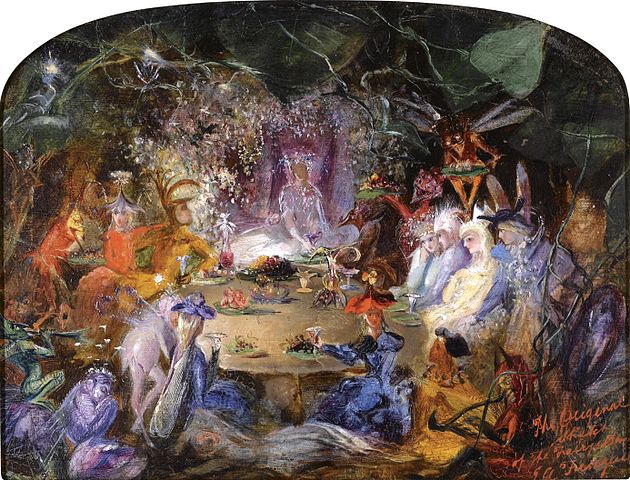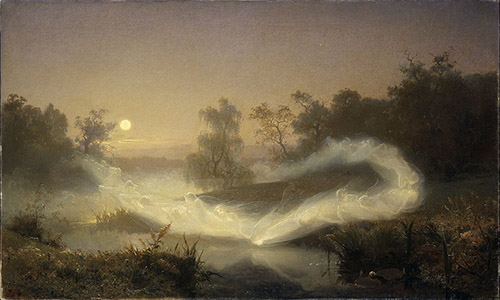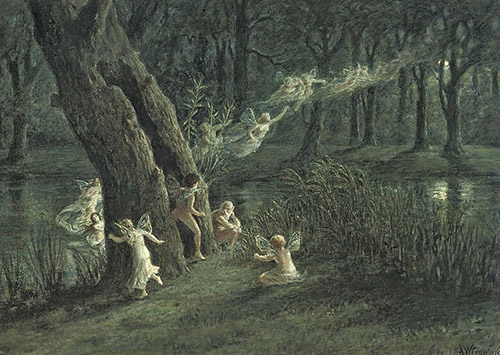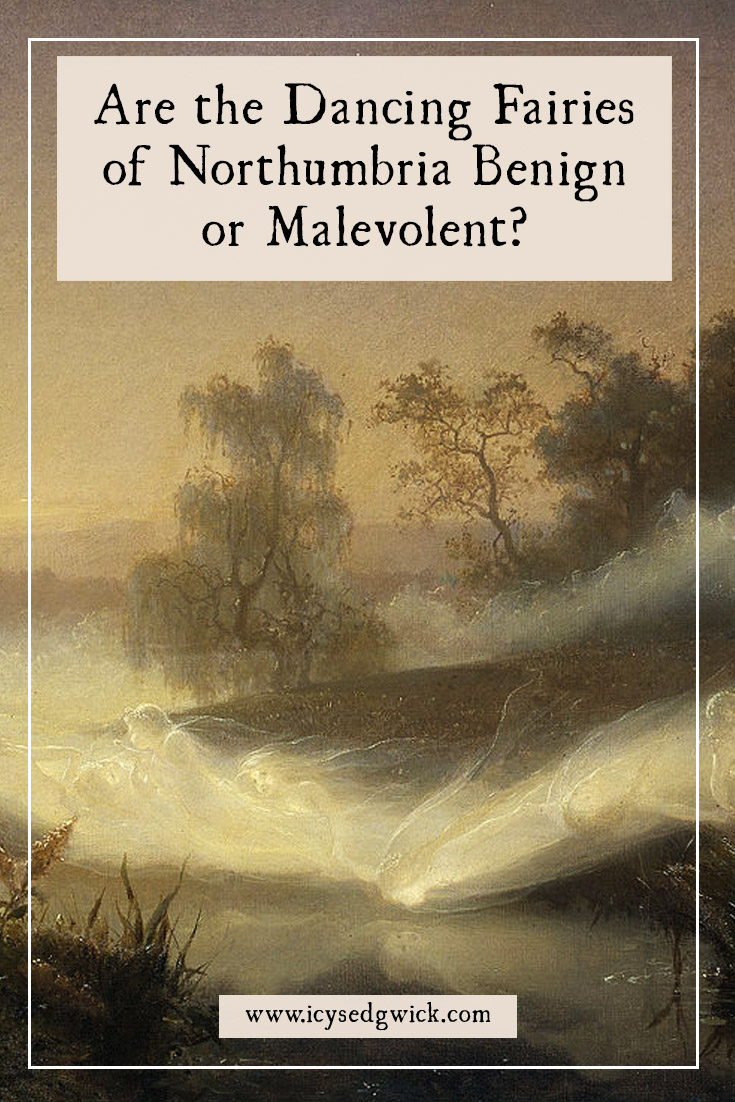Tales of fairies exist all over the world, and there are hundreds to choose from right here in the British Isles. Yet they often have a particular ‘flavour’ or motif that lets you group them together. One of the common motifs of folk tales in the northeast of England is that of dancing fairies. It seems the fairies in these parts loved a good feast, or a sing-song after dark.
Many of the stories are benign, with fairies simply enjoying a good knees-up and largely leaving human witnesses alone. Others see the fairies try to invite humans to join them—many of whom are never seen again.
In this post, we’re going to explore some tales of Northumbrian fairies, including hunters that disappear into Fairyland, fairy hills, and a milkmaid with the power to see fairies.
Northumberland vs Northumbria
I should point out the difference between Northumberland and Northumbria before we start. Northumberland is the county that stretches from the Borders in the north to the river Tyne in the south, with Cumbria to the west and the North Sea to the east.
Northumbria is the ancient kingdom that stretched from the Firth of Forth in the North to the Humber in the South. The Scots conquered the part of Northumbria north of the Cheviot hills, and the Danes grabbed the lands south of the Tees. The Normans later divided what was left into Northumberland and County Durham (Simpson 1991-2022).

So if anyone wonders why I’m talking about Teesdale in a post related to Northumbrian fairies, that’s because Teesdale originally was part of Northumbria!
Northumbrian Fairies
The fairies in Northumbria take a lot of different forms. One set of fairies is described as small yet well-proportioned, with golden hair and cream-coloured ponies. The fairies attached bells to their reins, though the ponies’ hooves made no marks on the ground. These fairies lived underground among the hills, and people would say they heard singing and dancing if they lay down to press their ear against the ground (Reynolds 1989: 19).
Castle Hill at Bishopton in Teesdale and Tower Hill at Middleton-in Teesdale are believed to be fairy hills. That might be news to the Conyers family who built their fortress at Bishopton!

In one legend, the town of Ferry Hill in County Durham is a derivation of ‘fairy hill’ (Reynolds 1989: 19).
That said, as we discovered in the folklore of place names post, another theory claims the name comes from ‘fiergen’, an Old English word meaning ‘wooded hill’ (KeystothePast.info 2021). A Dictionary of British Place-Names backs this one up, saying ‘fergen’ means wooded hill, and ‘hyll’ is just ‘hill’ (Mills 2011). So calling it ‘fergen hyll’ meant it was essentially Wooded Hill Hill. Not quite as cool as Fairy Hill.
Either way, stories of fairies in the area often involve this thread of singing and dancing.
Fairy Music
Some stories are incredibly pedestrian. A pile of stones made up a mound near Houghton-le-Spring, between Hetton and Eppleton. There was a small hole at the top, which locals called the “fairies’ cradle”. According to legend, a ghostly minstrel played music on his magical pipe, and the fairies danced along (Reynolds 1989: 20). So far, so good. People knew what was going on, and left them to it.
Because it’s not always a good idea to go looking for fairy music. Many believed Queen Mab and her fairy court lived on Fawdon Hill near Whittingham, where they enjoyed dancing and feasting at night. Fairies apparently travelled to Fawdon Hill from all over Britain to wait on Queen Mab.
There was even a poem to go with the hill!
“The sunbeam burst on Brandon Hall,
(Reynolds 1989: 21)
And burnish’d the windows and silver’d the wall,
And the crimson light of morning fell,
On Fawdon Hills, where the fairies dwell.”
But one night, a few centuries ago, a farmer found himself riding past Fawdon Hill at midnight. Beautiful music carried on the night air, and the farmer was sure the music came from inside the hill.
As he got closer, he could see that there was a vast door in the side of the hill. Inside, the fairy court enjoyed a magnificent banquet. The farmer stood and watched, seemingly unable to move, until the fairies spotted him. A page left the banquet and brought him a drinking cup. The farmer took the cup from the page, but he’d heard stories of fairy food and drink, so he dashed the drink to the ground and rode home as fast as possible (Reynolds 1989: 21).
This was the wisest course of action, given the stories of people trapped in Fairyland because they ate or drank something while they were there. (Sounds a lot like Persephone in Greek mythology, doesn’t it?)

Rupert Matthews offers a different version, in which a knight rides past the hill and sees the open doorway. Queen Mab beckons to him to enter, and when he doesn’t immediately move, she sends out a page with the silver wine goblet. Luckily, the knight spots the gleeful look on Queen Mab’s face before he drinks, and he casts the goblet away. The door slams shut, and he’s left on the hillside, thankfully in one piece (2009: 46). When nothing further happened, the knight picked up the goblet and rode off. According to legend, he gave it to King Henry I, who then gave it to King Alexander I of Scotland, who had it melted down.
Hen Hole
The fairies apparently also favoured the Hen Hole, a huge chasm to the southwest of the Cheviot, the highest peak in the Cheviot hills. According to folklore, the Hen Hole is so deep that the sun never reaches its depths, and you can still find snow there at Midsummer (Westwood 2005: 562). This otherworldly place seems to be an ideal spot for the fairies to hold their banquets.
One day, a group of hunters were chasing a deer, and they ended up beside the Hen Hole.

Beautiful music surrounded them, and the hunters forgot all about the deer (lucky deer!). They followed the music all the way to the Hen Hole – all but one of them went inside, while the remaining hunter stayed outside. Apparently, he didn’t like the look of the ground on the way into the chasm. He waited for his companions but eventually gave up, returning home alone. No one ever saw the other hunters again (Reynolds 1989: 21).
In another version of the story, the hunters chased a fox. A local shepherd named Ninian fell behind during the hunt since his pony couldn’t keep up. He arrived at the Hen Hole in time to see the hunt reach the edge of the chasm. A woman started singing inside the Hen Hole, and the beautiful music entranced the hunters, who directed their horses into the chasm. Ninian also tried to follow, but it took time for his pony to pick its way down towards the chasm. Once all the hunters disappeared into the darkness, the singing stopped, leaving Ninian and his pony alone on the hillside. No one ever saw the men, horses, or hounds again after they went into the Hen Hole (Matthews 2009: 40).
This particular folk tale also appears in other parts of the country, including Glen Quiech in Scotland, St Allen in Cornwall, and Nant Conwy in Wales (Westwood 2005: 562). It’s notable that these are the Celtic-language parts of Britain. The Hen Hole is just 345 m away from the Scottish border, so it’s unsurprising that a tale of fairies like this would also appear in this most northern part of England.
Fairy Rings
Of course, not all tales of feasting and dancing fairies end in disaster for humans. Although they could, if you didn’t take the proper precautions.
There was once a fairy ring north of Alnwick at Chathill, and fairies could be seen dancing around it at night. Children would sometimes dance around it too, but they were careful not to do it too much. If they danced around the ring more than nine times, evil would befall them (Reynolds 1989: 21).
A standing stone called the Hurl Stone in Lilburn also marks the spot of fairy dancing. It’s considered an ancient monument, and most people assume it once acted as some kind of boundary stone. But in the early 19th century, locals claimed fairies danced and sang around the stone, accompanied by a fairy playing the violin. Their favourite song apparently ran thus;
“Wind about and turn again,
(Westwood 2005: 562)
And thrive around the Hurl Stane:
Round about and wind again,
And thrive around the Hurl Stane.”
The fairies would dance and chant faster and faster until they moved quicker than the human eye could see (Matthews 2009: 44).
Another famous tale involved a milkmaid who lived at Netherwitton, near Morpeth. She carried her milk pail home on her head, and she peered into a field as she passed. To her friends, the field appeared empty. Yet she saw fairies dancing and capering. When she pointed them out, her friends insisted they saw nothing. The milkmaid told her family when she got home, and they prompted her to investigate further. Lo and behold, she found a four-leaved clover under the pail. According to folklore, having one of these leaves gave the holder the ability to see fairies (Reynolds 1989: 21).
What do we make of these dancing fairies?
It’s worth noting that a lot of these stories appear as a “friend of a friend told me” model. Indeed, in 1835, author Stephen Oliver asserted he’d only ever heard stories of encounters told by those whose immediate ancestors had apparently seen fairies. He hadn’t met anyone who’d actually seen their revels themselves (Westwood 2005: 564).
In some legends, the fairies dance among the ruins at Vindolanda, the Roman fortress a mile south of Hadrian’s Wall. It’s a wonderful place to visit, and you can see the remains of their under-floor heating system. Until archaeologists had figured out what these small chambers and tiny passages were for, some believed they were the homes of fairies.

Rupert Matthews notes that an 18th-century gentleman was told that the remains of the hypocaust system had belonged to fairies, which used it as their kitchen (2009: 44). People also thought the ruins at Housesteads were favoured for fairy feasts.
So there’s a possibility that the fairies became a way to explain the advanced engineering of Vindolanda or standing stones. Others think that the fairies might be people who predated the Iron Age civilisations. Of course, there is also the possibility that the fairies are real, and you can check out the Modern Fairy Sightings Podcast for far more recent stories of fairy encounters!
What do you make of these tales of singing and dancing fairies? Let me know below!
References
Keystothepast.info (2021), ‘Local History: Ferryhill (County Durham)’, Keystothepast.info, http://www.keystothepast.info/article/10339/Site-Details?PRN=D6793.
Matthews, Rupert (2009), Mysterious Northumberland, Derby: Breedon Books.
Mills, A.D. (2011), A Dictionary of British Place Names, first edition revised, Oxford: Oxford University Press.
Reynolds, Hazel (1989), More Ghosts and Legends of Northumbria, Morpeth: Coquet Editions.
Simpson, David (1991-2022), ‘Northumberland : Kingdom to County’, England’s North East, https://englandsnortheast.co.uk/northumberland-borderlands/.
Nutty about folklore and want more?
Add your email below and get these posts in your inbox every week.
You'll also get my 5-step guide to protecting your home using folklore!










So many folk sings deal with this… (“Borderlands” sung by Caswell Carnahan is one of my favorites, though I’m not sure how old it is.) Things like earth spirits, elementals and djinns make me cautious of what is out there to encounter.